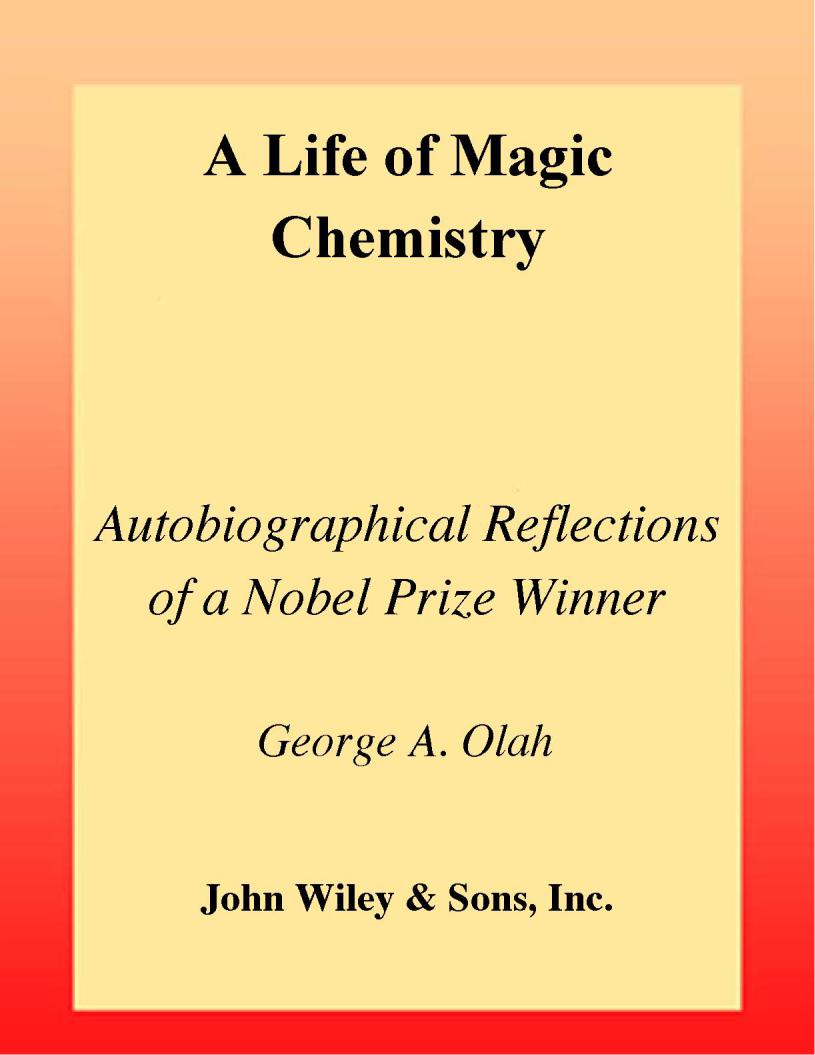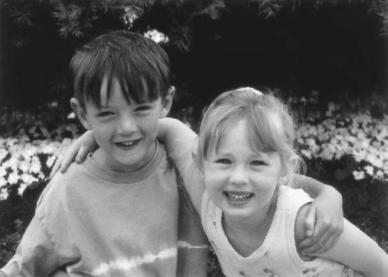
Olah G.A. - A Life of Magic Chemistry (2001)(en)
.pdf
A LIFE OF
MAGIC CHEMISTRY

A LIFE OF
MAGIC CHEMISTRY
Autobiographical Reflections of a
Nobel Prize Winner
George A. Olah
A JOHN WILEY & SONS, INC., PUBLICATION
New York • Chichester • Weinheim • Brisbane • Singapore • Toronto
This book is printed on acid-free paper.
Copyright 2001 by Wiley-Interscience. All rights reserved.
Published simultaneously in Canada.
No part of this publication may be reproduced, stored in a retrieval system or transmitted in any form or by any means, electronic, mechanical, photocopying, recording, scanning or otherwise, except as permitted under Sections 107 or 108 of the 1976 United States Copyright Act, without either the prior written permission of the Publisher, or authorization through payment of the appropriate per-copy fee to the Copyright Clearance Center, 222 Rosewood Drive, Danvers, MA 01923, (978) 750-8400, fax (978) 750-4744. Requests to the Publisher for permission should be addressed to the Permissions Department, John Wiley & Sons, Inc.,
605 Third Avenue, New York, NY 10158-0012, (212) 850-6011, fax (212) 850-6008, E-Mail: PERMREQ @ WILEY.COM.
For ordering and customer service call 1-800-CALL-WILEY.
Library of Congress Cataloging-in-Publication Data:
Olah, George A. (George Andrew), 1927–
A life of magic chemistry : autobiographical reflections of a nobel prize winner / George A. Olah.
p. cm.
Includes bibliographical references and index. ISBN 0-471-15743-0 (cloth : alk. paper)
1.Olah, George A. (George Andrew), 1927–. 2. Chemists—United States—Biography. I. Title.
QD22.043 A3 2000 |
|
|
|
|
|||||
540 .92—dc21 |
|
|
|
|
|
||||
[B] |
|
|
|
|
|
|
|
00-043638 |
|
Printed in the United States of America. |
|||||||||
10 |
9 |
8 |
7 |
6 |
5 |
4 |
3 |
2 |
1 |
To Judy,
who made it all possible

My grandchildren, Peter and Kaitlyn (July 1999).
Contents
Preface |
|
ix |
Chapter 1. |
Introduction |
1 |
Chapter 2. |
Perspectives on Science |
4 |
Chapter 3. Chemistry: The Multifaceted Central Science |
21 |
|
Chapter 4. Growing up in Hungary and Turning to Chemistry |
38 |
|
Chapter 5. |
Early Research and Teaching: Departing the |
|
|
Shadow of Emil Fischer |
51 |
Chapter 6. |
Move to North America: Industrial Experience While |
|
|
Pursuing the Elusive Cations of Carbon |
64 |
Chapter. 7. |
Return to Academia — The Cleveland Years: |
|
|
Carbocations, Magic Acid, and Superacid Chemistry |
84 |
Chapter 8. |
Moving to Los Angeles: Building the Loker Institute — |
|
|
Hydrocarbons and Hydrocarbon Research |
108 |
Chapter 9. |
‘‘Every Scientist Needs Good Enemies’’: |
|
|
The Nonclassical Ion Controversy and Its Significance |
137 |
Chapter 10. From Kekule´’s Four-Valent Carbon to Fiveand |
|
|
|
Higher-Coordinate Hypercarbon Chemistry |
153 |
Chapter 11. The Nobel Prize: Learning to Live with It and |
|
|
|
Not Rest on Laurels |
169 |
Chapter 12. |
Post-Nobel Years: From Superacids to Superelectrophiles |
188 |
vii

viii C O N T E N T S
Chapter 13. |
Societal and Environmental Challenges of Hydrocarbons: |
|
|
Direct Methane Conversion, Methanol Fuel Cell, and |
|
|
Chemical Recycling of Carbon Dioxide |
205 |
Chapter 14. |
Gone My Way |
222 |
Appendix |
My Previous Books for References and |
|
|
Additional Reading |
259 |
Index |
|
261 |
Preface
My wife Judy, my children, and my friends urged me for some time to write about my life and the fascinating period of science I was lucky to be part of. For years I resisted, mainly because I was still fully occupied with research, teaching, and various other commitments. I also felt it was not yet time to look back instead of ahead. However, I slowly began to realize that, because none of us knows how much time is still left, it might be ill advised to say ‘‘it is not yet the right time.’’ I therefore started to collect material and to organize my thoughts for a book.
It soon became clear that this project would be very different from any writing I had done before. I recognized that my goal was not only to give autobiographical recollections of my life and my career in chemistry but also to express some of my more general thoughts. These touch on varied topics, including the broader meaning of science in the quest for understanding and knowledge as well as their limitations. Science as a human endeavor means the search for knowledge about the physical world. Inevitably, however, this leads to such fundamental questions of how it all started and developed: Was there a beginning? Was our being planned by a higher intelligence? We struggle with these and related questions while trying to balance what we know through science and what we must admit is beyond us. My thoughts are those of a scientist who always tried to maintain his early interest in the classics, history, philosophy, and the arts. In recent years I have particularly tried to fill in some of the gaps; a life actively pursuing science inevitably imposes constraints on the time that one can spend reading and studying outside one’s own field of specialization. Of course, I realize only too well my limitations and the lack of depth in my background in some of these areas. Therefore, I have tried not to overreach, and I will limit my thoughts to my own understanding and views, however imperfect they may be.
This book is mainly about my life in search of new chemistry. Because some of my work centered around the discovery of extremely strong ‘‘superacids,’’ which are sometimes also called ‘‘magic acids,’’ I chose the title A Life of
ix

x P R E F A C E
Magic Chemistry. It also reflects in a more general way the exciting and sometimes indeed even ‘‘magic’’ nature of chemistry, which with its extremely broad scope cuts through many of the sciences, truly being a central science.
It was a long journey that led me from Budapest through Cleveland to Los Angeles with a side trip to Stockholm. Sometimes I still wonder how life unfolds in ways we could not have planned or foreseen.
I thank my publisher for the patience and understanding shown for my delays in writing the book. My editors Darla Henderson, Amie Jackowski Tibble, and Camille Pecoul Carter helped greatly to make the book a reality. My wife, sons, and friends helped to improve the manuscript and commented on its many shortcomings. My particular thanks go to Reiko Choy, my longtime secretary, who, before her retirement, miraculously produced a proper manuscript from my messy handwritten drafts and thus allowed the book to be completed. I similarly thank Jessie May, who took over and carried through with great efficiency and enthusiasm needed revisions and corrections.
George A. Olah
Los Angeles, October 2000
